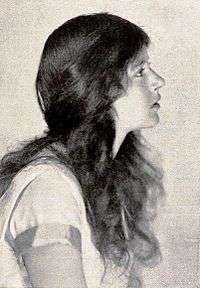Gentlemen Prefer Blondes (novel)
Gentlemen Prefer Blondes: The Intimate Diary of a Professional Lady (1925)[lower-alpha 1] is a comic novel written by American author Anita Loos. The story primarily follows the escapades and dalliances of a young blonde flapper in New York City and Europe during the Roaring Twenties. It is one of several novels published that year and exploring the hedonistic Jazz Age that have become famous—including F. Scott Fitzgerald's The Great Gatsby and Carl Van Vechten's Firecrackers.[1]
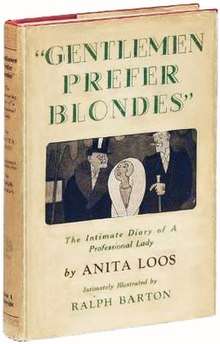 Cover of the first edition in 1925 | |
| Author | Anita Loos |
|---|---|
| Illustrator | Ralph Barton |
| Cover artist | Ralph Barton |
| Country | United States |
| Language | English |
| Series | Lorelei Lee |
| Genre | Comedic novel |
| Publisher | Harper's Bazaar Boni & Liveright |
Publication date | 1925 |
| Media type | Print (hardcover & paperback) |
| ISBN | 0-14-118069-2 |
| Followed by | But Gentlemen Marry Brunettes |
Loos was inspired to write the novel by an incident aboard a train bound for Hollywood: "I was allowed to lug heavy suitcases from their racks while men sat about and failed to note my efforts," she recalled, and yet, when another young woman "happened to drop the novel she was reading, several men jumped to retrieve it."[2][3] Loos surmised this difference in men's behavior was because she was a brunette and the other woman was a blonde.[2][3] When drafting the novel, Loos drew upon memories of observing "witless" blondes turn intellectual H.L. Mencken into a love-struck schoolboy.[4][2][3] Mencken, a close friend to whom Loos was attracted,[4] enjoyed the work and ensured its publication.[5]
Originally published as a series of short sketches in Harper's Bazaar magazine, the work was published in book form by Boni & Liveright in 1925. Although dismissed by critics as "too light in texture to be very enduring,"[6] Loos's book was a runaway best seller, becoming the second-best selling title of 1926, and printed throughout the world in over thirteen different languages.[7] The book earned the praise of writer Edith Wharton, who dubbed it "the great American novel."[2]
Loos published a sequel, But Gentlemen Marry Brunettes, two years later in 1927.[2] Several decades later, Loos was asked during a television interview in London whether she intended to write a third book. She facetiously replied that the title and theme of a third book would be Gentlemen Prefer Gentlemen.[8] This remark resulted in the interview's abrupt termination.[8]
Plot
A kiss on the hand may make you feel very nice, but a diamond and sapphire bracelet lasts forever.
— Lorelei Lee, Gentlemen Prefer Blondes[2]
Responding to a male friend's suggestion that she should write down her thoughts because it would make an interesting book, a blonde flapper named Lorelei[lower-alpha 2] narrates the novel in the form of a diary, complete with spelling and grammatical errors.[9] Born in Little Rock, Arkansas,[lower-alpha 3] Lorelei has been working in Hollywood movies where she meets Gus Eisman, a Chicago businessman whom she calls "Daddy." He installs her in a New York City apartment, visiting her whenever he is in town and spending a small fortune "educating" her to a higher standard of living. He pays for gowns from Madame Frances, jewelry from Cartier, dinners at the Ritz, and tickets to the Ziegfeld Follies. During this time, she continues seeing other men. She meets a married English novelist named Gerry Lamson, who frowns upon her liaison with Eisman. Lamson wishes to "save" her from Eisman and begs her to marry him. Not wishing to forgo an upcoming trip to Europe paid for by Eisman, Lorelei spurns Lamson and insists his highbrow discourses bore her.[10] Meanwhile, Lorelei is dismayed that her friend Dorothy Shaw wastes her time with a struggling poor boy named Mencken,[lower-alpha 4] who writes for a dull magazine[lower-alpha 5] when she could be spending time with the wealthy Edward Goldmark, a movie producer.[11]
— Diary Entry, March 16th[12]
Lorelei and Dorothy set sail for Europe on the RMS Majestic. Lorelei is distressed when she learns that Bartlett, a former district attorney who is now a U.S. Senator, is also aboard the ship. She tells a sympathetic Englishman about how she met Bartlett. She recounts a dubious backstory in which a libidinous lawyer once employed her as a stenographer, and she shot him in a fit of hysteria. During the trial, which Bartlett aggressively prosecuted, Lorelei gave such "compelling" testimony that the all-male jury acquitted her. The skeptical judge bought her a ticket to Hollywood so that she could use her acting talents to become a film star. The judge also nicknamed her "Lorelei"[lower-alpha 2] because he believed it expressed her true personality.[11]
Upon hearing this tale, the Englishmen tells Lorelei that he is an intelligence agent assigned to shadow Bartlett, who is traveling to Vienna for an international conference. He bribes Lorelei to seduce Bartlett and to betray her country by disclosing Bartlett's plans to him. Lorelei befriends Bartlett who—infatuated with her—begs her to come with him to Vienna. Bartlett reveals sensitive information which Lorelei relays to the Englishman. Her revenge complete, Lorelei hides in her cabin until Bartlett disembarks the ship.[11]
Dorothy and Lorelei arrive in England where they are unimpressed with the Tower of London, saying it is smaller than "the Hickox building in Little Rock." They are invited to a soirée where English aristocrats are selling possibly counterfeit "family jewels" to naive American tourists. Lorelei encounters an elderly matron who is selling a diamond tiara. Lorelei casts her eye around the room for a wealthy man to buy it for her and settles on Sir Francis Beekman, whom she calls "Piggie." With flattery and the promise of discretion, due to his matrimonial status, she persuades him to buy the tiara for her. Before departing the country, the two flappers meet the Prince of Wales, who is mystified by their American slang.[14]
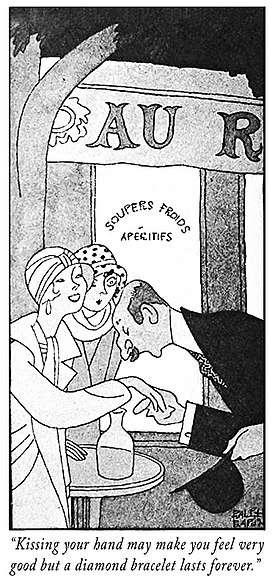
In Paris, the duo are more excited by jewelry shops than by the "Eyeful Tower."[15] Meanwhile, Beekman's wife has learned that her husband bought the tiara for Lorelei and arrives in Paris to confront her. She threatens to ruin her reputation if she does not return the tiara. Dorothy intercedes on Lorelei's behalf and points out that Lady Beekman's threats are hollow since Lorelei has no reputation to destroy.[15] The next morning, the flappers are confronted in their hotel suite by a Frenchman and his son. They learn that he is Lady Beekman's lawyer, and he implores them to return the tiara to his client. Impressed by the women's beauty, the French father and son invite the flappers to dine with them. Through a waiter, Lorelei learns that the lawyer plans to charge all expenses to Lady Beekman while secretly awaiting the opportunity to steal the tiara. Lorelei has a replica made of the tiara and—by playing the father and son against each other—she ultimately manages to keep the real tiara and send them away with the fake one.[15]
Eisman arrives in Paris and, after shopping trips with Lorelei, he departs for Vienna to examine a factory he wishes to buy.[16] He puts Lorelei and Dorothy on the Orient Express where she encounters Henry Spoffard, a staunch Presbyterian, prohibitionist, and moral reformer who delights in censoring movies. To gain his trust, Lorelei pretends that she is a reformer too and claims that she is trying to reform Dorothy from her sinful ways. Lorelei begins to dread arriving in Vienna and wonders how she can possibly spend time with both Eisman and Spoffard.[16]
In Vienna, Spoffard is concerned about Lorelei's mental health and insists she meet a "Dr. Froyd" (Sigmund Freud). Freud fails to psycho-analyze her because she has never repressed any desires and has no inhibitions. Later, Lorelei and Dorothy dine at the Demel Restaurant where they overhear Spoffard's mother being warned by a friend regarding Lorelei's bad reputation. Fearing her past will be revealed to Spoffard, Lorelei intercepts him and retells her past in a sympathetic light. Spoffard weeps at the moral outrages which Lorelei has supposedly endured and likens her to Mary Magdalene. He then arranges for Lorelei to meet his mother.[16] When the meeting occurs, Lorelei claims to be a Christian Scientist and that drinking champagne is encouraged by her religion. The two women become inebriated together. Spoffard's mother—who enjoys the champagne—decides that Christian Science is a more preferable religion than Presbyterianism. Lorelei gives her a modern hat to wear but, since Spoffard's mother has an Edwardian hairstyle, it does not fit, whereupon Lorelei uses a pair of scissors and bobs the woman's hair. The meeting is a success.[16] Soon after, Lorelei receives a letter from Spoffard proposing marriage. Unwilling to marry him, Lorelei plots to use this letter as future evidence of breach of promise and thus obtain a large financial pay-off from Spoffard's family.[16]
When she returns to New York City, Spoffard greets her and, as an engagement ring, he gives her his college signet which has great sentimental value to him.[17] Vexed by this inexpensive gift, Lorelei nonetheless assures him that the ring pleases her and that she is happy he is "so full of nothing but sentiment."[17] Bored in New York, Lorelei plans a debutante ball to mark her "debut" into polite society. She invites members of high society but also invites a gaggle of Follies chorus girls and a number of bootleggers with ties to organized crime. The riotous ball lasts three days until the police raid the party and arrest the guests. Disaster is forestalled when Dorothy wins over a sympathetic judge.[17]
Tiring of Spoffard, Lorelei plots to end her engagement by embarking upon a shopping spree and charging it all to Spoffard. While doing so, she meets Gilbertson Montrose, a movie scenario writer to whom she is attracted. She then enlists Dorothy's help to further nudge Spoffard towards breach of promise. To this end, Dorothy shows Spoffard a list of every item which Lorelei has bought and informs him that she is pathologically extravagant.[17] Meanwhile, Lorelei lunches with Montrose and tells him that she is ending her engagement to Spoffard. Montrose advises her that it would be wiser to marry Spoffard so that he could finance Montrose's new movie and so that she could star in the lead role. Lorelei now decides she will marry Spoffard and become a Hollywood star while pursuing a clandestine liaison with Montrose. She rushes to Penn Station and finds Spoffard. She falsely claims that all her extravagance was faked: Every jewel she bought was paste and it was a test of Spoffard's love. She tells him that he should be ashamed of himself. Remorseful, Spoffard vows to marry her and to finance Montrose's film. Lorelei gets everything she wants and declares that she is simply happy to make everyone else happy.[17]
Reception and reviews
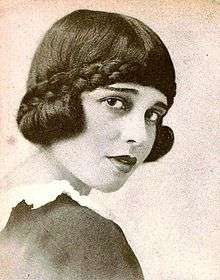
Gentlemen Prefer Blondes: The Intimate Diary of a Professional Lady was an instant success the moment it hit bookstores, selling out of all copies the day it was released.[5] A second edition of sixty thousand copies was likewise soon sold.[5] Afterward, the novel sold on average 1,000 copies per day. Its popularity eventually crossed national borders into countries such as the Republic of China and the Soviet Union, and the book was translated into more than a dozen different languages and published in 45 more editions.[7][18]
According to Loos, socialist journalists in foreign countries mistakenly interpreted the work to be an anti-capitalist polemic.[19] "When the book reached Russia," Loos recalled, "it was embraced by Soviet authorities as evidence of the exploitation of helpless female blondes by predatory magnates of the capitalistic system. The Russians, with their native love of grief, stripped Gentlemen Prefer Blondes of all its fun and the plot which they uncovered was dire." Their reviews focused upon "the early rape of its heroine, an attempt by her to commit murder, the heroine being cast adrift in the gangster-infested New York of Prohibition days, her relentless pursuit by predatory males, her renunciation of the only man who ever stirred her inner soul as a woman, her nauseous connection with a male who is repulsive to her physically, mentally and emotionally and her final engulfment in the grim monotony of suburban Philadelphia."[19] Loos denied any such political intentions in the work and was amused by such morose interpretations.[19]
Though the general public's appreciation of the story made Loos' satirical novel a success, it received numerous credible reviews and endorsements by renowned authors that secured the novel's reputation. Author William Faulkner wrote a personal letter to Anita Loos after reading her novel.[20] Filled with congratulatory remarks, Faulkner affirmed the brilliance of Gentlemen Prefer Blondes and complimented Loos regarding the originality of certain characters such as Dorothy Shaw.[20] Aldous Huxley, author of the dystopian novel Brave New World, also wrote a letter of praise to Loos. He expressed his desire to meet her because he was so "enraptured by the book" and "sincerely admired" her work.[20]
— William Faulkner, letter to Loos, 1926[20]
Among the list of names of other great authors from the time period, F. Scott Fitzgerald, E.B. White, Sherwood Anderson, William Empson, Rose Macauley, Edith Wharton, James Joyce, George Santayana, Herman J. Mankiewicz,[12] Arnold Bennett,[6] and H.G. Wells[6] also praised Loos for her work.[2][21] Wharton declared Gentlemen Prefer Blondes as "the great American novel," because the character of Lorelei Lee embodied the avarice, frivolity, and immoderation that characterized 1920s America.[2] Writer James Joyce stated that—even though his eyesight was failing him—he "reclined on a sofa reading Gentlemen Prefer Blondes for three days" while taking a break from writing Finnegans Wake.[2][5]
George Santayana, the Spanish-American philosopher and author, facetiously averred that Gentlemen Prefer Blondes was "the best book on philosophy written by an American."[2] Screenwriter Herman J. Mankiewicz gave Loos's book a rave review in The New York Times and summarized the novel as "a gorgeously smart and intelligent piece of work."[12] Arnold Bennett and H.G. Wells took Loos out to dinner when she visited London as a reward for her excellent work.[6] Even the Prince of Wales was reported to have been so amused by the novel that he purchased many copies of the book and gave them to his companions.[2][20][21]
Adaptations
Immediately following the widespread success of the book, Loos was contacted by Broadway impresario Florenz Ziegfeld who suggested to Loos that he adapt the story as a glamorous and sophisticated musical.[7] Ziegfeld said that actress Marilyn Miller—one of the most popular Broadway musical stars of the 1920s—should play the siren role of Lorelei Lee.[7] To her regret, Loos had already signed a contract with rival Broadway producer Edgar Selwyn to adapt the story as a straight comedy, and she could not break the contract.[7]
Under the contract with Selwyn, Loos and her playwright husband John Emerson adapted the novel as a Broadway stage play.[22] Brunette June Walker[23] was cast as Lorelei and performed the role in a blonde wig. Comedienne Edna Hibbard played Dorothy and Frank Morgan portrayed reformer Henry Spoffard.[22] The play debuted in Detroit[7] and was successfully performed 201 times from 1926–1927. As the first actress to portray Lorelei Lee, June Walker was instrumental in an interpretation that helped define the character. She was said to have "played a role that was as much her creation as that of Anita Loos."[23] "Tossing her golden curls, blinking her eyes and twirling her waist-length string of pearls," Walker's version of Lorelei embodied the flapper of the Roaring Twenties.[23] The success of the play launched Walker's career, and she had further Broadway successes.[23]
After the play's triumphant success, Loos licensed her novel for use in a daily newspaper comic strip series that ran from April 1926 to September 1926.[24][25] The comic strip was not an adaptation of the novel but placed its characters in new comedic situations. Although the writing was credited to Loos, it was presumably ghost-written by the artists, Virginia Huget and Phil Cook.[24] (This original 1926 series was reprinted in newspapers from 1929 to the early 1930s.[24][25])
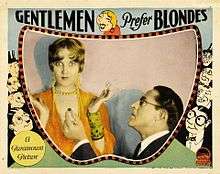
A year later, the book was adapted as a silent 1928 Paramount motion picture.[7] Under that contract, Loos and her husband Emerson wrote the screenplay and also had "to prepare the final scenario, select the cast, and have a hand in supervising the production," as well as write the inter-titles.[26] The film was directed by Malcolm St. Clair, and Lorelei Lee was played by Ruth Taylor. Loos hand-picked her for the role because she bore "a remarkable resemblance to Ralph Barton's illustrations in the book."[26] Loos later described Taylor's performance as "so ideal for the role that she even played it off-screen and married a wealthy broker."[7] (Following the film's success, Taylor married a prominent New York City businessman and became a Park Avenue socialite.[7]) For the 1928 film, Loos altered the story to include a prologue featuring Lorelei's grandfather as a gold-obsessed prospector and an epilogue in which Lorelei's impoverished Arkansas[lower-alpha 3] family learn via radio of her lavish wedding.[26]
By 1929, Loos' gold-digger epic had been adapted for a variety of different mediums: "It had been done in book form and serialized in magazines and syndicated in newspapers and designed into dress material and printed into wall paper and made into a comic strip and had even had a song by Irving Berlin."[7]
Over a decade later in 1941, theater director John C. Wilson suggested that Loos permit a musical adaptation of the story. However, Wilson's desired version never came to fruition. The musical adaptation was produced by Herman Levin and Oliver Smith, whom Loos met while sailing on a steamship to the United States from Europe.[7] The 1949 musical edition starred Carol Channing as Lorelei Lee and Yvonne Adair as Dorothy Shaw, and ran for 740 performances on Broadway.[22] The musical's success prompted a brief sartorial revival of 1920s fashions by dress factories.[7]
The second and more popular film adaptation of the novel was adapted from the musical and released in 1953.[27][25] This second motion picture adaptation was filmed in technicolor and featured Marilyn Monroe as Lorelei and Jane Russell as Dorothy.[27] In contrast to the Broadway musical, the 1953 film had to conform to the standards of the Motion Picture Production Code. It eschewed 1920s mores that had been represented before, in order to appease film censors who deemed any authentic cinematic interpretation of the Jazz Age to be impermissible.[28][29]
Notes
- The first edition of the book has the title Gentlemen Prefer Blondes: The Intimate Diary of a Professional Lady on the front jacket. However, the book cover, spine, and interior title pages state the title as Gentlemen Prefer Blondes: The Illuminating Diary of a Professional Lady. Reprints feature the latter title.
- The name "Lorelei" is a reference to the 1801 poem by German author Clemens Brentano which recounts the story of an siren who bewitches men and causes their deaths.[13] For further details, see folklore regarding Lorelei.
- Loos chose Little Rock as Lorelei's birthplace specifically due to H.L. Mencken's 1917 essay on American culture where he castigated the state of Arkansas for its ignorant inhabitants and contemptuously branded it as "the Sahara of the Bozart" (a pun on the Southern pronunciation of "beaux-arts").[4]
- This is a humorous reference to writer, essayist, and literary magazine editor H.L. Mencken. Author Anita Loos was an intimate friend of Mencken and regarded him as "an idol to adore for a lifetime."[4]
- This is a reference to H.L. Mencken's literary magazine The Smart Set which was one of the era-defining publications of the Roaring Twenties.[5]
References
- Fitzgerald 2003, p. 15: "[The Jazz Age represented] a whole race going hedonistic, deciding on pleasure."
- Clemons 1974.
- Loos 1998, pp. xxxvii, xxxviii, Preface.
- Rodgers 2005, p. 245.
- Loos 1998, p. xli, Preface.
- Loos Play Amuses London 1928.
- Loos 1949.
- Loos 1998, p. xlii, Preface.
- Loos 1998, p. 3.
- Loos 1998, pp. 3–18, Chapter 1.
- Loos 1998, pp. 19–32, Chapter 2.
- Mankiewicz 1925.
- Loos 1998, p. 26, Chapter 2.
- Loos 1998, pp. 33–50, Chapter 3.
- Loos 1998, pp. 51–73, Chapter 4.
- Loos 1998, pp. 74–98, Chapter 5.
- Loos 1998, pp. 99–123, Chapter 6.
- Loos 1998, pp. xli, xlii, Preface.
- Loos 1998, p. xxxix, Preface.
- Lester 2015.
- Rich 2015.
- Atkinson 1949.
- June Walker Obituary 1966.
- Holtz 2011.
- Encyclopedia of World Biography.
- Lorelei Lee On Film 1927.
- Crowther 1953.
- Brady 1946.
- Doherty 1999, p. 6.
Bibliography
- "Anita Loos". Encyclopedia of World Biography. Encyclopedia.com. Retrieved February 11, 2019.
- Atkinson, Brooks (December 9, 1949). "First Night at the Theatre: 'Gentlemen Prefer Blondes' with Carol Channing at the Ziegfeld" (PDF). The New York Times. p. 35. Retrieved June 28, 2019.CS1 maint: ref=harv (link)
- Brady, Thomas F. (October 13, 1946). "Alarum in Hollywood". The New York Times. pp. 65, 67. Retrieved June 28, 2019.
'The Johnston Office,' according to Richard Maibaum, forbade any motion picture which might kick-start 'a new jazz cycle' in American society.
CS1 maint: ref=harv (link) - Clemons, Walter (February 10, 1974). "Paperbacks: Gentlemen Prefer Blondes But Gentlemen Marry Brunettes". The New York Times. Retrieved February 2, 2019.CS1 maint: ref=harv (link)
- Crowther, Bosley (July 16, 1953). "The Screen In Review: 'Gentlemen Prefer Blondes' at Roxy, With Marilyn Monroe and Jane Russell". p. 17. Retrieved February 2, 2019.CS1 maint: ref=harv (link)
- Doherty, Thomas (1999). Pre-Code Hollywood: Sex, Immorality, and Insurrection in American Cinema 1930-1934. New York: Columbia University Press. p. 6. ISBN 0-231-11095-2.
The moral guardians tried their damnedest to break up the parade of wastrels marching in the vanguard of the Jazz Age assault on Victorian values. [...] The most significant pact between the censors and the censorable was the Production Code itself, adopted in 1930 to roll back the profligacy of the 1920s.
CS1 maint: ref=harv (link) - Fitzgerald, F. Scott (April 2003) [1945]. "Echoes of the Jazz Age". In Wilson, Edmund (ed.). The Crack-Up. New Directions. ISBN 978-0-8112-1820-7.CS1 maint: ref=harv (link)
- Holtz, Allan (October 10, 2011). "Obscurity of the Day: Gentlemen Prefer Blondes". Stripper's Guide. Retrieved June 22, 2019.CS1 maint: ref=harv (link)
- "June Walker, 65, First Lorelei Lee, Dies". The New York Times. February 5, 1966. p. 26. Retrieved June 28, 2019.
- Lester, Vickie (July 12, 2015). "Anita Loos Receives Notes From William Faulkner, Aldous Huxley, and F. Scott Fitzgerald". Beguiling Hollywood. Retrieved February 2, 2019.CS1 maint: ref=harv (link)
- "Loos Play Amuses London: Distinguished Audience Witnesses 'Gentlemen Prefer Blondes'". The New York Times. April 3, 1928. p. 32. Retrieved June 28, 2019.
- Loos, Anita (1998) [1925]. Gentlemen Prefer Blondes. Ralph Barton (illustrations). Liveright Publishing Corporation (W. W. Norton & Company). Retrieved June 28, 2019.CS1 maint: ref=harv (link)
- Loos, Anita (December 4, 1949). "Blondes' Biography". The New York Times. pp. 323, 325. Retrieved June 28, 2019.CS1 maint: ref=harv (link)
- "Lorelei Lee On Film: Anita Loos Has Made Slight Changes in 'Gentlemen Prefer Blondes'". The New York Times. December 18, 1927. p. 170. Retrieved June 28, 2019.
- Mankiewicz, Herman J. (December 27, 1925). "Here Are Humorists, Half a Dozen". The New York Times. p. 53. Retrieved June 28, 2019.CS1 maint: ref=harv (link)
- Rich, Nathaniel (March 29, 2015). "American Dreams: How Joyce and Faulkner Fell For a Blonde". The Daily Beast. Retrieved February 2, 2019.CS1 maint: ref=harv (link)
- Rodgers, Marion Elizabeth (2005). Mencken: The American Iconoclast. New York: Oxford University Press.CS1 maint: ref=harv (link)
